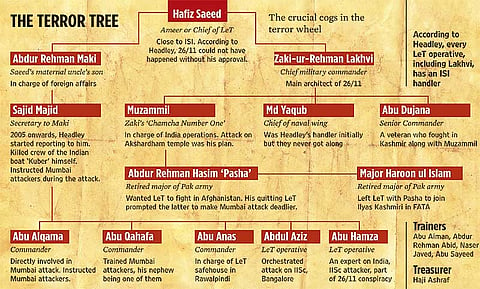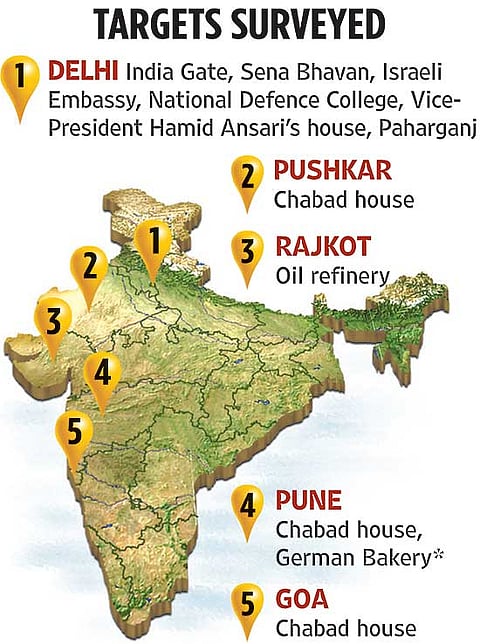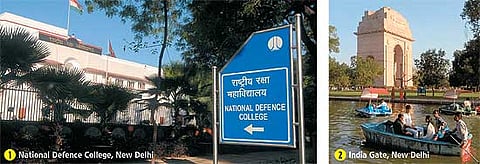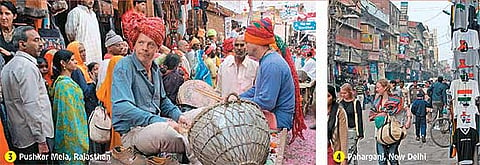The Union Republic of Terror
In his confessions to Indian officials, reconnaissance man David C. Headley has said enough to nail ISI’s link to the 26/11 attacks
This was a key moment in India’s war against terrorism. Here was a man who had served at close quarters with the LeT, Al Qaeda and the newly-formed ‘Karachi Set-up’ for almost a decade. His revelations gave Indian security officials major insights into a terror network that has become virtually an “independent state” within Pakistan.

This independent state, as outlined by Headley to NIA officials, has Pakistan’s ISI at its head, commands vast financial resources, uses technology at will, has an army of committed soldiers willing to die for the cause and has now become the fountainhead of a global terror network that poses a threat to several countries.
Even though the Americans did not allow NIA officials to make any audio or video recordings, their extensive notes form the basis for the 106-page interrogation report which Outlook has now accessed. Here are some of Headley’s key revelations in the report:

The 26/11 Terror Strike “The ISI, I believe, had no ambiguity in understanding the necessity to strike India,” Headley told the NIA team led by Lokenath Behera. It was under “tremendous pressure to stop any integration of Kashmir-based jehadi organisations with the Taliban-based outfits. It’s always in ISI interests to keep these two sets of outfits poles apart.”
The NATO presence in Afghanistan too was encouraging LeT fighters to leave in droves. They wanted a piece of the action there, but the ISI wanted to keep their covert war against India intact. “The aggression and commitment shown by several splinter groups in Afghanistan influenced many committed fighters to leave Kashmir-centric outfits and join the Taliban category of outfits. I understand this compelled the LeT to consider a spectacular terrorist strike in India.”
Initially, the planned attack was much smaller, with only the Taj as the intended target with a couple of attackers. But the intense pressure on ISI “accelerated the Mumbai attack project” and eventually turned it into “a grand plan of the LeT to strike Mumbai with multiple locations with multiple attackers”.
Headley made eight trips to India between 2006 and 2008. On each trip, he set up a logistic base in Mumbai to gather data without raising suspicion. He opened an account in “a bank housed in a building” near Hotel Outram in south Mumbai where he was staying. Being a charming man, he also made friends quickly, among them director Mahesh Bhatt’s son Rahul (to whom he even boasted about his Pakistan contacts) and others like Aswin Rajpal, Villas Varak and Kaniaz Messman.
Over the next few years, Headley also tried to get close to the Shiv Sena’s Rajram Rege in a bid to gain access to Sena supremo Bal Thackeray and his family who were a pet peeve for Hafiz Saeed. Interestingly, so successful was Headley that he continued to remain in touch with Rege even after the Mumbai attack and exchanged mails with him in 2009!
On his seventh trip to India in April 2008, Headley went on four boat rides; on April 12, he surveyed the Mumbai coast using a fisherman’s boat. He also took pictures of the CST railway station. In the third week of June, he was asked to go to Mumbai again. This was his eighth trip to India and the time he surveyed the Leopold Cafe#, the Israeli consulate and the Trident Hotel. He purchased red threads from the Siddhivinayak temple for the terrorists and fed in the coordinates into his GPS. Headley also travelled to the Wagah border to check the connectivity of a Vodafone SIM card, which the terrorists would use after they landed in Mumbai.
Interestingly, a key aspect of the attack was an elaborate escape plan for the terrorists. Headley had suggested the LeT’s top commanders ask the terrorists to attack the targets and melt into the crowd in the ensuing confusion. Subsequently, they’d take trains and buses to Delhi, proceed to Kashmir and then return to Pakistan. But this plan was dropped and it was decided instead to create strongholds in the hotels and Chabad House. This was now to be a suicide mission; returning home was no longer an option.
The bunch made three attempts to launch their attack. The first was in mid-September but they almost drowned as the sea was rough. The next attempt came in mid-October; this time the boat apparently hit a rock. The third attempt in November proved successful. Indian security agencies, which had received an alert in September and November, failed to connect the dots.
Headley also helped investigators identify the voices of handlers sending instructions to the holed-up terrorists. Many were veterans of terror attacks on India. Abu Hamza, the man who carried out the attack on the Indian Institute of Science in Bangalore, was a key planner, instructor and handler. So was Sajid Majid, a top LeT official. He was the one who asked the terrorists in Chabad House to ensure that none of the Israelis were left alive. Most of them were dead even before the National Security Guard could reach Mumbai. They also had plans to create a stronghold at the CST station but a police team, led by Mumbai’s joint commissioner of police Sadanand Date, foiled that plan.
The Role Of The ISI The LeT and other terror networks in Pakistan were no longer independent outfits, they were now a parallel state run with quiet and ruthless efficiency by the ISI. Headley named a number of senior serving army officers who worked with him and the LeT to plan and execute the 26/11 attack. The LeT’s top military commander, Zaki-ur-Rehman Lakhvi, fondly addressed as “Chacha” by the cadres, was quite close to ISI chief Lt Gen Shuja Pasha, contrary to the recent claims published by American journalist Bob Woodward in his latest book. Woodward writes that Pasha blamed a “rogue element” within the ISI for the Mumbai attack, but Headley says Pasha was always close to Lakhvi.
“Headley’s revelations,” says Srinath Raghavan, a senior fellow with the Centre for Policy Research, “suggest that Pakistan is having it both ways. It is making strategic use of the differing perceptions emanating out of Pakistan and weakening the scope of peace negotiations between New Delhi and Islamabad.”
Headley’s handler was a Major Iqbal, who also arranged funds and training in intelligence-gathering. Iqbal gave him $25,000 in August 2006 to visit India. Headley, in fact, also received a call from Iqbal while he was in India. “The call came from a number with a New York area code,” Headley told the Indian team. “I’m not sure what technology was used to make such a call.” Besides Iqbal, Headley also mentions a Colonel Shah, close to the LeT; a Lt Col Hamza; and another “brigadier” who spent a lot of time with Lakhvi.
The LeT, The Karachi Set-Up And Other Outfits Most of the top leaders of the LeT are veterans of terror strikes in Kashmir. Hafiz Saeed was its grand mufti, whose clearance was necessary for any attack. Lakhvi, who had lost his son during an encounter with the Indian army, was his second-in-command. He is suspected to be a former Pakistani soldier who has risen from the ranks to become practically the top military commander of the outfit. Another key architect was a man called Muzammil, who Headley describes as Lakhvi’s main “chamcha”. He was involved in the killing of Sikhs in Chittisinghpora nearly a decade ago. He also planned the Akshardham attack in Gujarat.
The LeT, says Headley, is now busy expanding. It has set up a naval wing to target India and is also looking at bases abroad. It sent a man identified as Abu Anas in 2006 to set up base in Thailand by opening a restaurant. Interestingly, Anas had met Osama bin Laden, an indication that the various strands of terror outfits are getting woven into a global alliance of sorts. And the one common thread running through them is the ISI.
And LeT is not the only one. Around 2003-04, the Karachi Set-up began making its presence felt. Led by Abdur Rehman Pasha, it drew Indian youth from Gujarat and Maharashtra to train them in terror tactics. This group too had the ISI’s support with Col Shah being Pasha’s handler. The Mumbai train attack, says Headley, was executed by the Karachi Set-up using Pasha-trained Indian men.
Now, other outfits known as the 313 Brigade and the Jund ul Fida, some with links to Al Qaeda, are being set up to target India. According to Headley, the Jund ul Fida will work under the 313 Brigade and “carry out attacks in India and other non-Islamic countries”. The outfit’s name, says Headley, “has been chosen by Osama bin Laden”.
Future Targets Surveyed


Future Targets Headley has also revealed the future targets the LeT and its allied outfits had looked at. Four months after 26/11, Headley was back on a recce trip to India. On a final trip in March 2009, he surveyed a number of places that he says may be future targets of terror attacks. He describes in chilling detail his visit to the National Defence College in Delhi, where the best and the brightest senior officers destined to be generals are trained. Headley tracked the bus that would carry the officers from their quarters a few kilometres away to the ndc every day. He recommended this as an ideal and “vulnerable target” to his ISI handlers.
Headley spent time in Delhi, Pushkar, Goa and Pune. He spent time studying possible Israeli targets, including the various Chabad Houses in Goa, Pushkar and the crowded Paharganj area where budget tourists put up in Delhi. He also surveyed India Gate and Vice President Hamid Ansari’s house as possible targets. He conducted extensive surveillance of the house as well as the Sena Bhavan and the Israeli Embassy, and shot more video footage of Paharganj, which, he believes, “seemed a likely target”. All the video footage was handed over to his ISI handlers in Pakistan before he left for the US.
From Delhi, Headley travelled to Pushkar, Goa and finally Pune. In Pune, he filmed the Chabad House and the German Bakery which would be targeted by bombs a few months later. Headley also believes the LeT was planning another attack on the oil refinery in Rajkot, Gujarat.
Headley’s interrogation establishes the ISI link to terror attacks in no uncertain terms. The 106-page interrogation report will be an important document in India’s case against Pakistan-sponsored terror strikes in India.
Tags